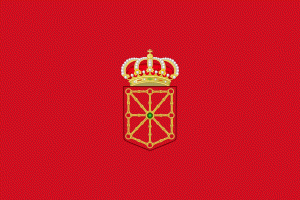Navarre (Navarra)
 |
 |
Navarre is in the transition zone between Green Spain and semi-arid interior areas, and thus its landscapes vary widely across the region. Being in a transition zone also produces a highly variable climate, with summers that are a mix of cooler spells and heat waves, and winters that are mild for the latitude. Navarre is one of the historic Basque districts: its Basque features are conspicuous in the north, but virtually absent on the southern fringes. The best-known event in Navarre is the annual festival of San Fermín held in Pamplona in July.
The first documented use of a name resembling Navarra, Nafarroa, or Naparroa is a reference to navarros, in Eginhard's early-9th-century chronicle of the feats of the Holy Roman Emperor Charlemagne, describing his intrusion to the Ebro river. Other Royal Frankish Annals feature nabarros. There are two proposed etymologies for the name.
* Basque nabar (declined absolute singular nabarra): "brownish", "multicolour" (i. e. in contrast to the green mountainous lands north of the original County of Navarre).
* Basque naba (or Spanish nava): "valley", "plain" + Basque herri ("people", "land").
The linguist Joan Coromines considers naba to be linguistically part of a wider Vasconic or Aquitanian language substrate, rather than Basque per se.
The official name in Basque is Nafarroa, but the form Nafarroa Garaia "Upper Navarre" is also often seen, to distinguish the province from neighboring Lower Navarre.
Map - Navarre (Navarra)
Map
Country - Spain
 |
 |
| Flag of Spain | |
Anatomically modern humans first arrived in the Iberian Peninsula around 42,000 years ago. The ancient Iberian and Celtic tribes, along with other pre-Roman peoples, dwelled the territory maintaining contacts with foreign Mediterranean cultures. The Roman conquest and colonization of the peninsula (Hispania) ensued, bringing the Romanization of the population. Receding of Western Roman imperial authority ushered in the migration of different non-Roman peoples from Central and Northern Europe with the Visigoths as the dominant power in the peninsula by the fifth century. In the early eighth century, most of the peninsula was conquered by the Umayyad Caliphate, and during early Islamic rule, Al-Andalus became a dominant peninsular power centered in Córdoba. Several Christian kingdoms emerged in Northern Iberia, chief among them León, Castile, Aragon, Portugal, and Navarre made an intermittent southward military expansion, known as Reconquista, repelling the Islamic rule in Iberia, which culminated with the Christian seizure of the Emirate of Granada in 1492. Jews and Muslims were forced to choose between conversion to Catholicism or expulsion, and eventually the converts were expelled through different royal decrees.
Currency / Language
| ISO | Currency | Symbol | Significant figures |
|---|---|---|---|
| EUR | Euro | € | 2 |
| ISO | Language |
|---|---|
| EU | Basque language |
| CA | Catalan language |
| GL | Galician language |
| OC | Occitan language |
| ES | Spanish language |
















